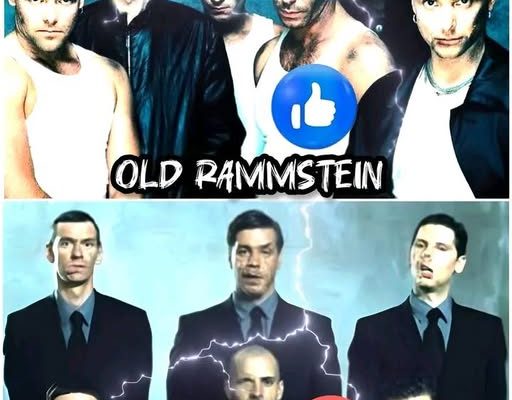Rammstein is not just a band. They are a phenomenon, a storm that rose out of the smoke and sweat of the 1990s and reshaped the very landscape of industrial metal. To understand the essence of Rammstein is to understand two worlds, two different but connected eras of fire, steel, and raw emotion: the Old Rammstein of the 90s, and the New Rammstein of today. Each era carries its own weight, its own power, and its own unrelenting presence. What ties them together is the undeniable force of music that refuses to bow, a music that sets its own rules and burns through every stage it touches. Old Rammstein was a creature born of chaos, steeped in the grit of East Germany’s post-reunification landscape, where industrial decline, cultural tension, and raw aggression fused into something unprecedented. From the very beginning, the band presented itself as unapologetically loud, physical, and threatening. Their riffs were pounding like steel hammers, the drums relentless as war machines, and above it all, Till Lindemann’s deep, commanding voice that could swing from whispers to guttural growls to operatic cries. This was music not designed for polite radio play but for invasion — an assault on the senses that resonated deeply with those who felt alienated, angry, or hungry for something dangerous. Songs like “Du Hast” and “Engel” were more than hits; they were cultural detonations. “Du Hast,” with its repetitive, mechanical drive, became an anthem of defiance, built on a rhythm that mirrored the grinding heart of an industrial factory, each lyric echoing like the words of a stern, unyielding command. “Engel,” by contrast, brought in haunting female vocals that twisted alongside the band’s heaviness, creating a dark hymn that was both alluring and menacing. These songs ignited a fire across the world, particularly at a time when audiences were eager for something new, something that didn’t fit neatly into American grunge or British alt-rock. Rammstein’s old sound was the birth of Neue Deutsche Härte — the New German Hardness — and it established the band not only as musicians but as icons of an entire genre.
But it was not only the sound that defined Old Rammstein. It was the imagery, the performance, the willingness to shock. Fire was not an accessory for the band; it was their language. Till Lindemann wielded flamethrowers, stages erupted in controlled infernos, and every concert felt like a ritual of destruction and rebirth. For many in the 90s, Rammstein represented something primal — a return to the raw force of music as spectacle, where aggression and power were not hidden but celebrated. They were gritty, aggressive, and absolutely unapologetic, carrying the energy of a band with nothing to lose, hungry to carve their name into rock history.
As time moved forward, bands born in chaos often lose their edge, softening as success and fame dilute their hunger. But with Rammstein, the story is different. Old Rammstein may have been raw and explosive, but New Rammstein — the band of today — is proof that fire does not fade; it evolves. Now older, wiser, and far more experienced, Rammstein is, paradoxically, more dangerous than ever. Their sound has not mellowed with age. If anything, it has grown sharper, heavier, more precise. The production is now razor-sharp, sculpted with decades of technical mastery and access to resources they could only dream of in the 90s. Where once their riffs sounded like iron chains rattling in a factory, now they strike like forged steel blades — heavier, more cutting, and impossible to ignore.
What makes New Rammstein so compelling is that they channel their aggression not only through sheer force but through intention. The anger, the menace, the provocation — it is now refined, shaped like a weapon, aimed with accuracy at the world around them. Their lyrics are no longer simply declarations of defiance or raw emotion; they have become sharp dissections of politics, taboos, and the darkest corners of the human psyche. Rammstein today does not shy away from the uncomfortable. Instead, they revel in it, using their music as both mirror and magnifying glass to show society its contradictions, hypocrisies, and forbidden desires.
This evolution is evident in the way the band carries itself. The raw hunger of the 90s has been replaced by a commanding confidence. They are no longer simply storming the world — they are shaping it. Their stage shows, still reliant on fire and pyrotechnics, have grown into some of the most complex and awe-inspiring spectacles in music. It is not just about shock anymore; it is about creating a full, overwhelming experience that fuses music, theater, and art into something unforgettable. The infernos remain, but now they burn with purpose, controlled and deliberate, a blazing inferno that reflects decades of perfected craft.
Yet beneath the refinement, the essence of Rammstein remains unchanged. The primal force, the aggressive heartbeat, the industrial growl — it all still thrums within the band’s core. The difference is perspective. Old Rammstein was about release, about breaking out of cages and roaring into the world with fists clenched and teeth bared. New Rammstein is about mastery, about knowing exactly how to channel that same fire into a storm that is not only powerful but enduring. If Old Rammstein was dynamite, exploding in all directions, New Rammstein is a controlled detonation, a nuclear blast focused with devastating precision.
One of the most striking things about the band’s journey is how they have remained relevant across decades. Many bands from the 90s have either faded into nostalgia or struggled to adapt to new eras of music. Rammstein, on the other hand, has grown stronger, their fanbase expanding, their shows selling out worldwide, their albums continuing to top charts. They have managed to stay true to themselves while also evolving in ways that keep their music vital and fresh. This is not simply survival; it is domination.
Part of this success comes from their ability to balance contradiction. They are older but not weaker, heavier but not sluggish, provocative but not gratuitous. Their music continues to walk the fine line between the accessible and the transgressive, drawing in mainstream audiences while still unsettling them. Rammstein thrives on discomfort, on tension, on forcing listeners to confront things they might otherwise avoid. In doing so, they maintain a dangerous edge, one that makes every new release an event, every concert a spectacle, and every era a new chapter in a story that refuses to end.
Old Rammstein and New Rammstein are not separate entities but two sides of the same fire-forged coin. The raw grit of the 90s was the foundation, the primal scream that announced their arrival. The refined power of today is the evolution, the sharpened blade forged from years of hammering in the furnace of fame, controversy, and relentless performance. Together, they create a legacy that is unmatched in modern music, a legacy that bridges generations and transcends language. Whether shouting in German or roaring through guitars and drums, Rammstein speaks a universal tongue: power, defiance, and fire.
The world today is different from the one that birthed Rammstein in the 90s. It is more connected, more digital, more fractured in its politics and culture. And yet, Rammstein fits into this world with uncanny precision. Their music, now more than ever, feels necessary — a soundtrack to chaos, a mirror to society’s darkest impulses, and a reminder that art is not supposed to comfort but to provoke, to ignite, to burn. Old Rammstein gave the world raw fire. New Rammstein ensures that fire has not dimmed but has instead become an inferno that lights up stadiums, headlines, and the imaginations of millions.
What remains constant across both eras is the band’s refusal to compromise. They are unapologetically themselves, whether in 1997 or in 2025, standing tall against critics, controversy, and censorship. Rammstein has always been about pushing boundaries, and that defiance is what keeps them alive, what keeps them dangerous. The grit of the past and the precision of the present are not opposites but evolutions, part of a single journey that shows no signs of stopping.
As fans old and new gather under the blazing lights of their concerts, as riffs thunder and flames shoot toward the sky, one truth becomes clear: Rammstein is timeless. They are not bound by decades, not trapped by trends. Old Rammstein was the explosion that shook the world. New Rammstein is the unstoppable blaze that continues to consume it. And somewhere in that fire, in the pounding drums, the roaring guitars, and Till Lindemann’s indomitable voice, lies the essence of a band that was always more than music — a band that became legend, that became myth, that became fire itself.



